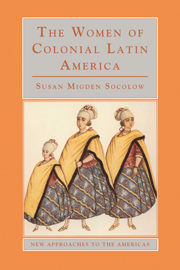Book contents
- Frontmatter
- Contents
- List of Illustrations
- Acknowledgments
- Introduction: Why Women?
- 1 Iberian Women in the Old World and the New
- 2 Before Columbus: Women in Indigenous America and Africa
- 3 Conquest and Colonization
- 4 The Arrival of Iberian Women
- 5 Women, Marriage, and Family
- 6 Elite Women
- 7 The Brides of Christ and Other Religious Women
- 8 Women and Work
- 9 Women and Slavery
- 10 Women and Social Deviance: Crime, Witchcraft, and Rebellion
- 11 Women and Enlightenment Reform
- Conclusion
- Documents
- Suggested Further Reading
- Index
- Plate section
Introduction: Why Women?
Published online by Cambridge University Press: 05 June 2012
- Frontmatter
- Contents
- List of Illustrations
- Acknowledgments
- Introduction: Why Women?
- 1 Iberian Women in the Old World and the New
- 2 Before Columbus: Women in Indigenous America and Africa
- 3 Conquest and Colonization
- 4 The Arrival of Iberian Women
- 5 Women, Marriage, and Family
- 6 Elite Women
- 7 The Brides of Christ and Other Religious Women
- 8 Women and Work
- 9 Women and Slavery
- 10 Women and Social Deviance: Crime, Witchcraft, and Rebellion
- 11 Women and Enlightenment Reform
- Conclusion
- Documents
- Suggested Further Reading
- Index
- Plate section
Summary
Gender is crucial to individual identity and, in all societies, to the roles individuals will play and the experiences they will have. The position of men and women in any society is a social construct, not a natural state. Each society and every social group has a culture that defines the roles and rules of masculinity and femininity; by conforming to these definitions an individual becomes a “legitimate” man or woman.
The goal of this book is to examine these roles and rules and thus understand the variety and limitations of the female experience in colonial Latin America. One overarching limitation in both Spanish and Portuguese America was the existence of a patriarchal social organization. In the New World as in the Old, a clear sexual hierarchy placed women below men. By law and by tradition, men held the lion's share of power in government, religion, and society. Furthermore, a man, particularly a father, was supreme within his family. Legally, all those living within the household were required to obey him.
In this society women were defined first and foremost by their sex and only secondarily by their race or social class. In many colonial documents the lack of attention to women's race and class suggests that these attributes were malleable. Sex was not. Indeed it can be argued that sex was the most important factor in determining a person's status in society.
- Type
- Chapter
- Information
- The Women of Colonial Latin America , pp. 1 - 4Publisher: Cambridge University PressPrint publication year: 2000

